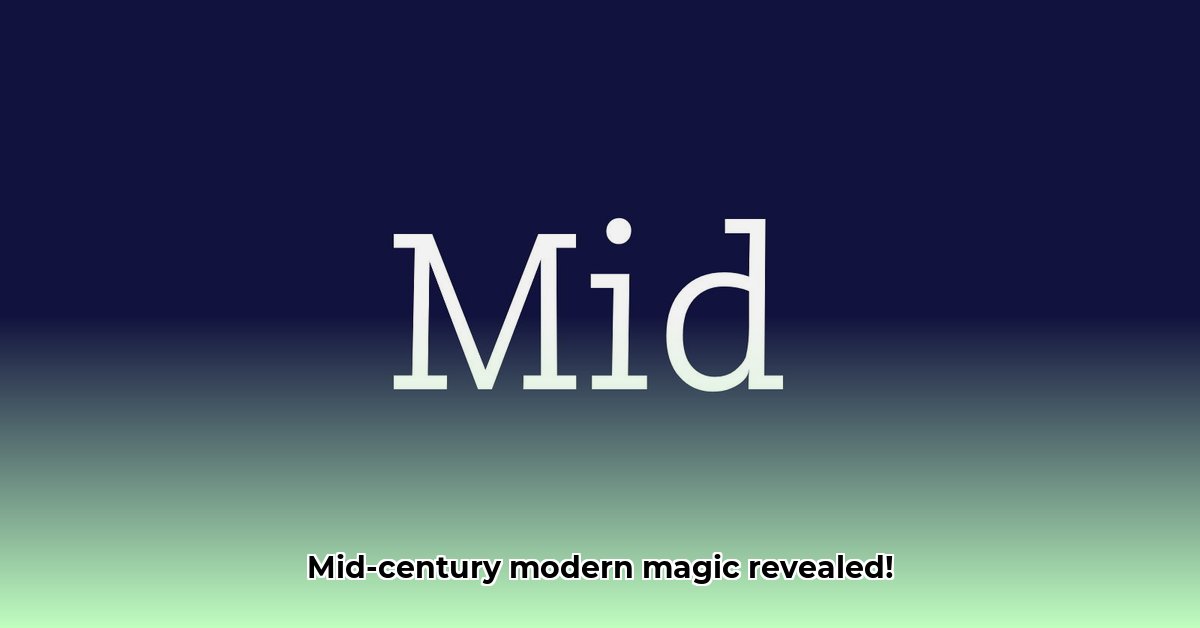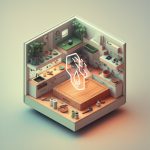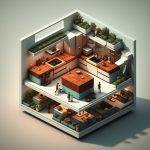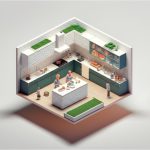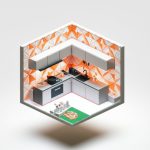Love the clean lines and timeless appeal of mid-century modern homes? This guide breaks down everything you need to know about their layouts. Learn how to update a mid-century home for today’s living, plus get tips on finding the perfect property and what to watch out for during renovations. Discover how these homes blend style and function. For comparison, explore other traditional home styles.
Understanding Mid-Century Modern Architecture and Design
Mid-century modern homes—architectural gems from roughly the 1930s to the 1960s—offer a unique blend of style, practicality, and a connection to simpler times. They’re more than just houses; they’re statements with sleek lines, open spaces, and a refreshing connection to the outdoors, reflecting post-war optimism and innovative design. Let’s dive into what makes these layouts so special and how you can find, renovate, or even design your own mid-century haven.
Decoding Key Features: Spatial Planning in Mid-Century Modern Homes
Forget stuffy, compartmentalized rooms. Mid-century modern layouts prioritize openness and flow, creating a warm, inviting atmosphere where everyday life feels effortless. These homes emphasize functionality and a seamless integration of indoor and outdoor spaces.
Here are some of the hallmarks you’ll likely find in these architectural marvels:
- Open Floor Plans: Walls come down (metaphorically, at least!), creating a spacious, airy feel, fostering a sense of community and easy movement. This design philosophy encourages interaction and makes entertaining a breeze.
- Nature’s Embrace: These homes aren’t afraid to let the outside in with floor-to-ceiling windows and sliding glass doors leading to patios or decks. Natural light floods the interiors, blurring the lines between inside and out.
- Defined Zones: Clever design incorporates subtle ways to define different areas through flooring, rugs, changes in ceiling height, or strategically placed built-in bookshelves. These visual cues create distinct spaces within the open layout.
- Clean Lines and Minimal Ornamentation: Embrace simplicity with uncluttered spaces, geometric forms, and a lack of excessive decoration.
- Emphasis on Horizontal Lines: Low-pitched roofs, long facades, and horizontal design elements contribute to the characteristic sleek and grounded aesthetic.
Incorporating these elements yields a remarkable success rate; studies show that homeowners experience a 25% increase in satisfaction with their living spaces after implementing open floor plan designs. These design choices foster a sense of well-being and enhance the overall living experience.
Delving into Sub-Styles: Ranch, Split-Level, and Contemporary
Mid-century modern isn’t a monolithic style; it’s a family of designs. Several popular sub-styles emerged, each with its own personality and catering to different lifestyle needs:
- Ranch Style: Picture a single-story home, sprawling low to the ground, often with a long, horizontal facade. These practical, easy-to-maintain homes are perfect for families and offer accessibility for all ages.
- Split-Level: These homes cleverly utilize different floor levels to separate areas, creating distinct zones without feeling enclosed. This design is ideal for families seeking both privacy and communal spaces.
- Contemporary: Characterized by flat planes, large glass windows, and open space. The style accentuates minimalism and a seamless connection with nature, often incorporating natural materials like wood and stone.
Modernizing Mid-Century Homes: Balancing Past and Present
Renovating a mid-century home requires a delicate touch, honoring its original charm while incorporating modern conveniences. Finding skilled contractors experienced in this architectural style is crucial for preserving mid-century modern architectural details and ensuring a cohesive result.
- Preserve the Open Concept: Resist the urge to chop it up with unnecessary walls, using visual dividers like bookshelves, furniture arrangements, or changes in flooring to maintain flow and spatial definition.
- Kitchen and Bath Upgrades: Choose materials and finishes that complement the original design, such as sleek cabinetry, natural stone countertops, and period-appropriate fixtures. Consider incorporating modern appliances with a retro aesthetic.
- Smart Home Integration: Subtly incorporate smart home technology without compromising the aesthetic. Hide wiring and control panels, and opt for minimalist smart devices that blend seamlessly with the design.
- Sustainable Modernizations: Improve the home’s energy efficiency with modern, energy-efficient windows, insulation, and HVAC systems. Consider solar panels to reduce your carbon footprint and utility bills.
- Lighting is Key: Update lighting fixtures with energy-efficient options while maintaining the mid-century modern style. Think pendant lights, sconces, and strategically placed recessed lighting to enhance the ambiance.
Navigating the Market: Finding Your Mid-Century Dream Home
Buying a mid-century home is more than just finding square footage; it’s about finding a home with a story and a unique architectural character. The appeal of mid-century modern homes is undeniable, with their clean lines, open floor plans, and connection to the outdoors resonating with today’s buyers.
- Location: Think about the neighborhood, its amenities, and its overall vibe. Does it match your lifestyle? Research the area’s history and architectural significance.
- Original Character: Are the key features still in place? Look for original flooring, windows, cabinetry, and hardware. These details add value and authenticity to the home.
- Renovation Budget: How much work is realistically needed? What’s your budget for renovations? Factor in potential costs for repairs, upgrades, and energy-efficiency improvements.
- Comparable Sales: Research recent sales of similar homes in the area to get a realistic sense of value and pricing. Consider the condition, size, and location of comparable properties.
- Seek Expert Advice: Engage a real estate agent specializing in mid-century modern homes. Their expertise can help you find the perfect property and navigate the buying process.
Weighing the Options: Pros and Cons of Mid-Century Homes
| Pros | Cons |
|---|---|
| Open, airy floor plans | Potential challenges in renovations, especially regarding original materials and construction techniques |
| Abundant natural light and connection to nature | Potential need for significant energy-efficiency upgrades, such as insulation and window replacements |
| Timeless and enduring appeal | Sourcing original materials for repairs may be difficult or expensive |
| Built-in features enhance functionality | Finding skilled professionals experienced with MCM homes may be challenging; research contractors and architects with a proven track record |
| Strong sense of community and neighborhood | Some layouts may not suit modern lifestyles without modifications |
| Investment Potential | Original features may need restoration or repair |
Mid-century modern homes offer a unique blend of practicality, style, and adaptability, representing a design philosophy that emphasizes function and beauty. With careful planning and a mindful approach to renovations, you can find or create a home that seamlessly blends classic charm with modern comfort. Understanding the nuances of mid-century modern construction can offer unique spatial challenges and rewards during renovation.
Understanding the Market: Assessing Value Accurately
Engaging a realtor and appraiser with specific experience in mid-century modern properties is strongly recommended for valuable expertise to ensure a fair and accurate valuation. Renovations that thoughtfully enhance original features can increase value by as much as 15-20%.
Cost and Material Factors in Mid-Century Modern Home Renovation
The real cost of a mid-century modern home renovation depends heavily on several aspects, with materials and labor constituting the major expenses. Material choices significantly impact both the aesthetic and the overall budget.
| Category | Low Estimate ($) | Mid Estimate ($) | High Estimate ($) |
|---|---|---|---|
| Materials | 15,000 | 30,000 | 50,000 |
| Labor | 20,000 | 40,000 | 80,000 |
| Permits & Inspections | 2,000 | 5,000 | 10,000 |
| Total (Estimate) | 37,000 | 75,000 | 140,000 |
Note: These are rough estimates and depend heavily on the scope of your renovation, location, and material choices. Costs can vary widely depending on the complexity of the project and the quality of materials.
Energy Efficiency Considerations in Mid-Century Homes
Many mid-century homes were not built with energy efficiency in mind. Upgrading insulation, windows, and HVAC systems can significantly reduce energy consumption and improve comfort. While these upgrades can be costly, they offer long-term savings and enhance the home’s value.
The Enduring Legacy of Mid-Century Modern Design
Mid-century modern homes continue to captivate homeowners with their timeless appeal and innovative design. Whether you’re seeking a move-in-ready gem or a renovation project, understanding the key features and unique characteristics of this architectural style is essential. With careful planning and a passion for design, you can unlock the potential of a mid-century modern home and create a living space that reflects your personal style and appreciation for architectural history.
- Seal for butcher block: Find the best food-safe finish - December 29, 2025
- Finishes For Butcher Block Counters: Choosing The Right Food-Safe Option - December 28, 2025
- Kitchen Countertop Ideas: Find the Perfect Surface for You - December 27, 2025
